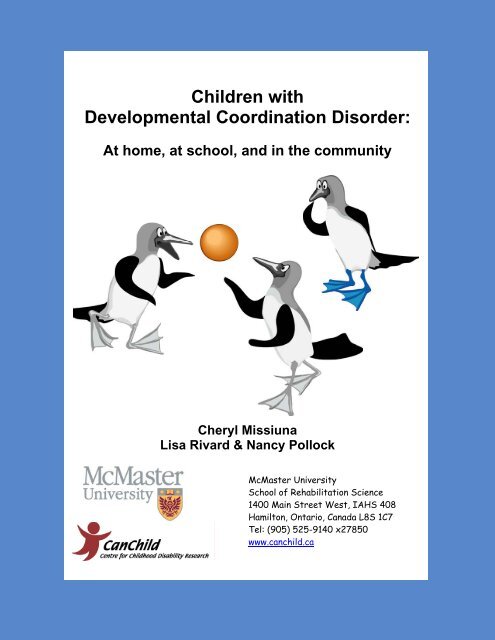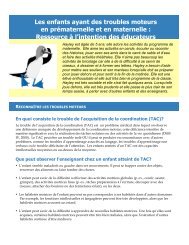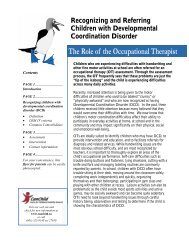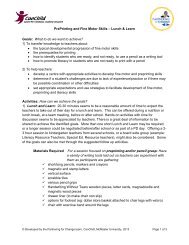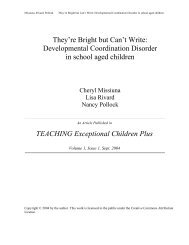Children with Developmental Coordination Disorder - CanChild ...
Children with Developmental Coordination Disorder - CanChild ...
Children with Developmental Coordination Disorder - CanChild ...
Create successful ePaper yourself
Turn your PDF publications into a flip-book with our unique Google optimized e-Paper software.
<strong>Children</strong> <strong>with</strong><strong>Developmental</strong> <strong>Coordination</strong> <strong>Disorder</strong>:At home, at school, and in the communityCheryl MissiunaLisa Rivard & Nancy PollockMcMaster UniversitySchool of Rehabilitation Science1400 Main Street West, IAHS 408Hamilton, Ontario, Canada L8S 1C7Tel: (905) 525-9140 x27850www.canchild.ca
IntroductionThis booklet is designed to help parents and educators identify and manage school-agedchildren who are demonstrating movement problems typical of children <strong>with</strong> <strong>Developmental</strong><strong>Coordination</strong> <strong>Disorder</strong> (DCD). Based on research evidence, the purpose of this booklet is todescribe common characteristics of children <strong>with</strong> motor coordination difficulties, to provideguidance for seeking a referral to a physician, to describe the role of occupational therapists andphysiotherapists who may work <strong>with</strong> these children, and to suggest modifications that mayimprove the ability of children to function at home, at school, and in the community.Some children only experience coordination difficulties while others have associated learning,speech/language, and attention problems. Management of children <strong>with</strong> DCD varies greatly dueto these differences. As a result, particular techniques and strategies may be more appropriate forone child than another. This booklet describes some of the more common techniques andpractical suggestions that may be used. An occupational therapist and/or a physiotherapist maywish to highlight or add specific techniques to personalize it for a particular child/student.The authors gratefully acknowledge the many parents, children, educators, colleagues, students,and service providers who have contributed their knowledge and expertise to the development ofthis booklet. This booklet was developed <strong>with</strong> support from the Canadian Occupational TherapyFoundation and funding from the Canadian Institutes of Health Research to facilitate earlyidentification of children <strong>with</strong> DCD.What is <strong>Developmental</strong> <strong>Coordination</strong> <strong>Disorder</strong>?<strong>Developmental</strong> <strong>Coordination</strong> <strong>Disorder</strong> (DCD) occurs when a delay inthe development of motor skills, or difficulty coordinating movements,results in a child being unable to perform everyday tasks. A diagnosiscan be made by a medical doctor who will ensure: 1) that the movementproblems are not due to any other known physical, neurological, orbehavioural disorders; and, 2) whether more than one disorder may bepresent. The characteristics of children <strong>with</strong> DCD, however, are usuallynoticed first by those closest to the child because the motor difficultiesinterfere <strong>with</strong> academic achievement and/or <strong>with</strong> activities of dailyliving (e.g., dressing, playground skills, handwriting, gym activities).DCD is believed to affect 5-6% of school-aged children and tends to occur more frequently inboys. DCD can exist on its own or it may be present in a child who also has learning disabilities,speech/language difficulties, and/or attention deficit disorder. In this booklet, the coordinationdifficulties that are discussed are those that are most often seen in children <strong>with</strong> developmentalcoordination disorder.© C. Missiuna, L. Rivard & N. Pollock, 2011; <strong>CanChild</strong> Centre for Childhood Disability Research, McMaster University 1
How Do <strong>Coordination</strong> Difficulties Occur?There is no simple answer to this question since coordination difficulties can arise for manyreasons. Although we do not know for sure what causes motor coordination problems, researchsuggests that children can experience difficulties in learning how to plan, organize, perform,and/or modify their movements. One thing we know for certain is that children <strong>with</strong> DCD havedifficulty learning new motor skills. They tend to use their vision more than other types offeedback to guide their movements and, because of this, their motor skills may be more likethose of younger children. <strong>Children</strong> <strong>with</strong> DCD perform inconsistently from one occasion to thenext, and they often perform motor skills in the same way over and over again, even when theyare unsuccessful. Typically, children <strong>with</strong> DCD depend on feedback and are not able to predictthe outcome of their movements. As a result, they don’t easily recognize movement errors, learnfrom their mistakes, or correct their movements.The characteristics described above have led researchers to believe that the coordinationdifficulties of children <strong>with</strong> DCD may lie not only in learning how to move their bodies but alsoin learning how to use strategies to problem-solve solutions to motor tasks. Because motor skillsdo not become automatic for these children, they must devote extra effort and attention tocomplete motor tasks, even those that have been previously learned. <strong>Children</strong> <strong>with</strong> DCD oftendon’t recognize the similarities of particular motor tasks, and this leads to difficulties transferringtheir motor learning from one activity to another (e.g., catching a large ball and then catching asmall ball). They also have difficulty generalizing their motor learning from one situation toanother (e.g., a child approaching a sidewalk curb has to figure out that stepping up onto thesidewalk is similar to climbing stairs). Having to respond to a changing environment (e.g., whencatching or hitting a moving ball, or when avoiding others during team play) poses an additionalchallenge for children <strong>with</strong> DCD because they find it hard to monitor incoming information fromthe environment and to make their bodies respond in a timely way. The result of any of theseproblems is the same: children <strong>with</strong> DCD appear clumsy and awkward, and will have difficultylearning and performing new motor tasks.Characteristic Features of <strong>Children</strong> <strong>with</strong> DCDWhen describing children <strong>with</strong> DCD, it is important to recognize thatthey are a very mixed group. Some children may experiencedifficulties in a variety of areas, while others may have problemsonly <strong>with</strong> specific activities. The following is a list of some of themore common characteristics that may be observed in a child <strong>with</strong>DCD.Physical Characteristics1. The child may be clumsy or awkward in his/her movements.He/she may bump into, spill, or knock things over.2. The child may experience difficulty <strong>with</strong> gross motor skills (wholebody), fine motor skills (using hands), or both.The Blue-Footed Boobie-Bird of theGalapagos Islands has personality andtalent – it can fly incredibly high into theair and dive into the ocean; it can evendo a very funny dance. Despite thesestrengths, this unique bird has a lot oftrouble landing and often goes for atumble. We selected this bird as a mascotfor our DCD educational materials sothey will be easy to identify and will beattractive to share <strong>with</strong> children.© C. Missiuna, L. Rivard & N. Pollock, 2011; <strong>CanChild</strong> Centre for Childhood Disability Research, McMaster University 2
3. The child may be delayed in developing certain motor skills such as riding a tricycle/bicycle,catching a ball, jumping rope, doing up buttons, and tying shoelaces.4. The child may show a discrepancy between his/her motor abilities and his/her abilities in otherareas. For example, intellectual and language skills may be quite strong while motor skills aredelayed.5. The child may have difficulty learning new motor skills. Once learned, certain motor skills maybe performed quite well while others may continue to be performed poorly.6. The child may have more difficulty <strong>with</strong> activities that require constant changes in his/herbody position or when he/she must adapt to changes in the environment (e.g., baseball, tennis).7. The child may have difficulty <strong>with</strong> activities that require the coordinated use of both sides ofthe body (e.g., cutting <strong>with</strong> scissors, stride jumps, swinging a bat, or handling a hockey stick).8. The child may exhibit poor postural control and poor balance particularly in activities thatrequire balance (e.g. stair climbing, standing while dressing).9. The child may have difficulty <strong>with</strong> printing or handwriting. This skill involves continuallyinterpreting feedback about the movements of the hand while planning new movements, and is avery difficult task for most children <strong>with</strong> DCD.Emotional/Behavioural Characteristics1. The child may show a lack of interest in, or avoid, particular activities, especially those thatrequire a physical response. For a child <strong>with</strong> DCD, performing motor skills requires significanteffort. Fatigue and repeated failure may cause the child to avoid participating in motor tasks.2. The child may demonstrate a low frustration tolerance, decreased self-esteem, and a lack ofmotivation due to difficulties coping <strong>with</strong> activities that are required in all aspects of his/her life.3. The child may avoid socializing <strong>with</strong> peers, particularly on the playground. Some children willseek out younger children to play <strong>with</strong> while others will play on their own or follow the educatoror playground supervisor. This may be due to decreased self-confidence or avoidance of physicalactivities.4. The child may seem dissatisfied <strong>with</strong> his/her performance (e.g., erases written work,complains of performance in motor activities, shows frustration <strong>with</strong> work product).5. The child may be resistant to changes in his/her routine or in his/her environment. If the childhas to expend a lot of effort to plan a task, then even a small change in how it is to be performedmay present a significant problem for the child.© C. Missiuna, L. Rivard & N. Pollock, 2011; <strong>CanChild</strong> Centre for Childhood Disability Research, McMaster University 3
Other Common Characteristics1. The child may have difficulty balancing the need for speed <strong>with</strong> the need for accuracy. Forexample, handwriting may be very neat but extremely slow.2. The child may have difficulty <strong>with</strong> academic subjects such as mathematics, spelling, or writtenlanguage which require handwriting to be accurate and organized on the page.3. The child may have difficulty <strong>with</strong> activities of daily living (e.g., dressing, using a knife andfork, brushing teeth, doing up zippers, organizing a backpack).4. The child may have difficulty completing work <strong>with</strong>in an expected time frame. Since tasksrequire much more effort, children may be more willing to be distracted and may becomefrustrated <strong>with</strong> a task that should be straightforward.5. The child may have general difficulties organizing his/her desk, locker, homework, or even thespace on a page.If a child exhibits any number of the above characteristics and if these problems are interfering<strong>with</strong> the child's ability to participate successfully at home, at school, or in the community, then itis important to have the child seen by a family doctor or pediatrician. The medical practitionermay then refer the child to a health service provider at a local children’s hospital or treatmentcentre or to another community agency.It is not uncommon for parents or educators to be told that a child will "grow out" of theirdifficulties. However, studies have now shown quite conclusively that most children do notoutgrow these problems. While children do learn to perform certain motor tasks well, they willcontinue to have difficulty <strong>with</strong> new, age-appropriate tasks. It is important to recognize thesemotor difficulties because children <strong>with</strong> DCD are more likely to develop academic andbehavioural problems, demonstrate low self-esteem, depression, and anxiety, and they are atgreater risk of becoming overweight.The Role of TherapistsOccupational therapists (OTs) and physiotherapists (PTs) are educated and trained in analyzingmotor skill development and also in determining the ability of a child to cope <strong>with</strong> the demandsand activities of everyday life. Both are uniquely suited for making recommendations for themanagement of a child <strong>with</strong> movement problems. In today’s health care environment, OTs andPTs often function in the role of consultant; this is particularly true of therapists working <strong>with</strong>inschool settings. In a consultant role, the therapist will observe the child performing tasks that aredifficult for him/her and make recommendations to his/her parents and educators. Theserecommendations may include: strategies or accommodations to assist <strong>with</strong> tasks at home, atschool, or in the community; modifications to the child’s environment; ways to promote physicalactivity and increase participation; guidelines on choosing community leisure and sportsactivities that are matched to the child’s interests and abilities; and assistance <strong>with</strong> settingappropriate expectations to ensure success.© C. Missiuna, L. Rivard & N. Pollock, 2011; <strong>CanChild</strong> Centre for Childhood Disability Research, McMaster University 4
OTs and PTs can help parents, educators and the child to develop a better understanding of thecoordination difficulties that the child is experiencing. It is important that parents and educatorsidentify and learn to manage these problems early in order to prevent secondary complications.The child may need to be taught strategies to compensate for his/her motor problems and must begiven adequate opportunities to practice those motor skills that need to be learned.It is important to educate children <strong>with</strong> DCD so they become aware of their strengths, as well astheir limitations, and so that they gain an understanding of ways in which they may compensatefor any difficulties. <strong>Children</strong> will then be more likely to experience success and may be morewilling to attempt activities that they find difficult.If a child is experiencing a great deal of difficulty or is demonstrating secondary emotional andbehavioral problems, the OT or PT may decide to work <strong>with</strong> the child individually on a shorttermbasis. The therapist may do some direct skill teaching of motor tasks that the child needs orwants to learn. S/he may also use a cognitive approach that teaches the child problem-solvingstrategies that will help the child learn new motor tasks (this type of approach requires a therapistto have extra training). In either case, the reasons and plan for treatment will be discussed <strong>with</strong>the parent and child. Although in most cases the coordination difficulties do not disappear,children can show considerable improvement in their ability to perform specific tasks and can behelped to participate successfully at home, at school, and in the community.The Role of Educators and ParentsThere are many small modifications that can make life easier for a child <strong>with</strong> DCD. Here are afew ideas that may be useful; an OT or PT may have additional suggestions.At Home1. Encourage the child to participate in games and sports that are interesting to him/her andwhich provide practice in, and exposure to, motor activities. Physical activity and enjoymentshould be emphasized rather than proficiency or competition.2. Try to introduce the child to new sports activities or a new playground on an individual basis,before he/she is required to manage the activity in a group. Try to review any rules and routinesthat are associated <strong>with</strong> the activity (e.g., baseball rules, soccer plays) at a time when the child isnot concentrating on the motor aspects. Ask the child simple questions to ensure comprehension(e.g., "What do you do when you hit the ball?"). Private lessons may be helpful at certain pointsin time to teach the child specific skills.3. The child may exhibit a preference for, and perform better at, individual sports (e.g.,swimming, running, bicycling, skiing) rather than team sports. If this is the case, then try toencourage the child to interact <strong>with</strong> peers through other activities that are likely to be successful(e.g., cubs, music, drama, or art).© C. Missiuna, L. Rivard & N. Pollock, 2011; <strong>CanChild</strong> Centre for Childhood Disability Research, McMaster University 5
4. Encourage the child to wear clothing to school that is easy to get on and off. For example,sweat pants, sweat shirts, t-shirts, leggings, sweaters, and Velcro shoes. When possible, useVelcro closures instead of buttons, snaps or shoelaces. Teach the child how to manage difficultfasteners when you have more time and patience (e.g., on the weekend, or over the summer)rather than when you are pressured to get out the door.5. Encourage the child to participate in practical activities that will help improve his/her ability toplan and organize motor tasks. For example, setting the table, making lunch, or organizing aknapsack. Ask questions that help the child focus on the sequence of steps (e.g., “What do youneed to do first?”). Recognize that, if your child is becoming frustrated, it may be time to help orto give specific guidance and direction.6. Recognize and reinforce the child’s strengths. Many children <strong>with</strong> DCD demonstrate strongabilities in other areas – they may have advanced reading skills, a creative imagination,sensitivity to the needs of others, and/or strong oral communication skills.At SchoolEducators and parents can work together to ensure that the child <strong>with</strong> DCD experiences successat school. Parents may find it helpful to meet <strong>with</strong> the educator near the beginning of the schoolyear to discuss their child’s specific difficulties and to make suggestions about strategies thathave worked well. An Individualized Education Plan (IEP) may be needed for some children;however, the following accommodations may be sufficient for others.In the Classroom:1. Ensure that the child is positioned properly for deskwork.Make sure that the child's feet are flat on the floor, and that thedesk is at an appropriate height <strong>with</strong> the shoulders relaxed andthe forearms comfortably supported on the desk.2. Set realistic short-term goals. This will ensure that both thechild and educator continue to be motivated.3. Provide the child <strong>with</strong> extra time to complete fine motoractivities such as math, printing, writing a story, practicalscience tasks, and artwork. If speed is necessary, be willing toaccept a less accurate product.4. When copying is not the emphasis, provide the child <strong>with</strong> prepared worksheets that will allowhim/her to focus on the task. For example, provide children <strong>with</strong> prepared math sheets, pages<strong>with</strong> questions already printed, or 'fill in the blank' for reading comprehension questions. Forstudy purposes, photocopy notes written by another child.5. Introduce computers as early as possible to reduce the amount of handwriting that will berequired in higher grades. Although keyboarding may be difficult initially, it is a very beneficialskill and is a skill at which children <strong>with</strong> movement problems can become quite proficient.© C. Missiuna, L. Rivard & N. Pollock, 2011; <strong>CanChild</strong> Centre for Childhood Disability Research, McMaster University 6
6. Teach children specific handwriting strategies that encourage them to print or write letters in aconsistent manner. Use thin magic markers or pencil grips if they seem to help the child improvepencil grasp or to reduce pencil pressure on the page.7. Use paper that matches the child's handwriting difficulties. For example:• widely spaced lines for a child who writes <strong>with</strong> very large lettering;• raised, lined paper for a child who has trouble writing <strong>with</strong>in the lines;• graph paper for a child whose writing is too large or improperly spaced;• graph paper <strong>with</strong> large squares for a child who has trouble keeping numbers alignedin mathematics.8. Focus on the purpose of the lesson. If a creative story is the goal, then accept messyhandwriting, uneven spacing and multiple erasures. If the goal is to have the child learn to set upa math problem correctly, then allow time to do it even if the math problem does not get solved.9. Consider using a variety of presentation methods when asking the child to demonstratecomprehension of a subject. For example, encourage children to present a report orally, usedrawings to illustrate their thoughts, type a story or report on the computer, or record a story orexam on a tape recorder.10. Consider allowing the child to use the computer for draft and final copies of reports, storiesand other assignments. If it is important to see the “non-edited” product, ask the child to submitboth the draft and final versions.11. When possible, encourage the child to dictate stories, book reports, or answers tocomprehension questions to the educator, a volunteer, or another child. For older children, voicerecognition software can be introduced as soon as the child’s voice patterns have maturedenough that they are consistent.12. Provide additional time, and/or computer access, for tests and exams that require a lot ofwritten output.In Physical Education:1. Break down the physical activity into smaller parts whilekeeping each part meaningful and achievable.2. Choose activities that will ensure success for the child at least50% of the time and reward effort, not skill.3. Incorporate activities that require a coordinated response fromarms and/or legs (e.g., skipping, bouncing and catching a largeball). Encourage children to develop skills using their hands in adominant/assistant fashion (e.g., using a baseball bat or a hockeystick).© C. Missiuna, L. Rivard & N. Pollock, 2011; <strong>CanChild</strong> Centre for Childhood Disability Research, McMaster University 7
4. Keep the environment as predictable as possible when teaching a new skill (e.g., place a ballon a T-ball stand). Introduce changes gradually after each part of the skill has been mastered.5. Make participation, not competition, the major goals. With fitness and skill-building activities,encourage children to compete <strong>with</strong> themselves, not others.6. Allow the child to take on a leadership role in physical education activities (e.g., captain of theteam, umpire) to encourage them to develop organizational or managerial skills.7. Modify equipment to decrease the risk of injury to children who are learning a new skill. Forexample, Nerf balls in graduated sizes can be used to develop catching and throwing skills.8. When possible, provide hand-over-hand guidance to help the child get the feel of themovement - for example, by asking the child to help the educator demonstrate a new skill to theclass. Also, talk out loud when teaching a new skill, describing each step clearly.9. Focus on understanding the purpose and the rules of various sports or physical activities.When a child understands clearly what he/she needs to do, it is easier to plan the movement.10. Give positive, encouraging feedback. If providing instruction, describe the movementchanges specifically (e.g., “you need to lift your arms higher”).In the Community1. Encourage exposure to physical activities for fun and participation, <strong>with</strong> an emphasis on healthand fitness.2. Consider lifestyle sports such as swimming, skating, cycling, and skiing to maintain orimprove strength and overall endurance.3. Keep in mind the potential need for extra support or individual lessons <strong>with</strong> sporting activities,especially as higher skill levels must be reached.4. Ensure safety through the use of protective gear (wrist guards, helmets) <strong>with</strong> physicalactivities.5. Help coaches, sports instructors, and community leaders understand the child’s strengths andchallenges so they can support and encourage them to be successful.6. Encourage children to engage in activities that are non-motor based such as music, drama,clubs to promote social experiences and the benefits of social participation.© C. Missiuna, L. Rivard & N. Pollock, 2011; <strong>CanChild</strong> Centre for Childhood Disability Research, McMaster University 8
Summary<strong>Developmental</strong> <strong>Coordination</strong> <strong>Disorder</strong> is a motor skill disorder that interferes <strong>with</strong> children'sability to perform many tasks that are required every day. <strong>Children</strong> <strong>with</strong> DCD are a mixed group.Any given child may present <strong>with</strong> a variety of different problems.Educators and parents who are <strong>with</strong> a child every day may be the first to notice the difficultiesthat the child is experiencing. It is important for the child to be seen by a physician at an earlyage to rule out other medical reasons for their motor difficulties. <strong>Children</strong> <strong>with</strong> DCD who are notrecognized may experience failure and frustration, are often perceived to be lazy or unmotivated,and may develop additional physical, social, and behavioural problems.Intervention for children <strong>with</strong> DCD may include referral to an occupational therapist orphysiotherapist. An OT and/or PT will help the child learn to perform daily tasks moresuccessfully and will make recommendations to parents and educators regarding the participationof children <strong>with</strong> DCD at home, in the classroom, on the playground, and in leisure activities inthe community.Contrary to the widely accepted belief that children <strong>with</strong> DCD will outgrow their problems,studies have demonstrated that children may acquire certain skills <strong>with</strong> extra practice but newmotor skills will still be a problem. <strong>Children</strong> <strong>with</strong> DCD require early intervention to help themlearn strategies to compensate for their coordination difficulties, to feel better about themselvesas individuals, and to prevent other secondary issues from developing.ResourcesMany resources about children and youth <strong>with</strong> DCD can be found on the <strong>CanChild</strong> website at:www.canchild.ca (click on “<strong>Developmental</strong> <strong>Coordination</strong> <strong>Disorder</strong>”). These include:Information for Physicians and other Health ProfessionalsFlyers and Resources for EducatorsTyping/Keyboarding and School-Related RecommendationsEncouraging Physical ActivityList of Books/Other ResourcesIf you have found this booklet to be helpful, please let us know:McMaster UniversitySchool of Rehabilitation Science1400 Main St. West, IAHS Bldg, Rm 408Hamilton, ON L8S 1C7Tel: (905) 525‐9140 ext 27850canchild@mcmaster.cawww.canchild.ca© C. Missiuna, L. Rivard & N. Pollock, 2011; <strong>CanChild</strong> Centre for Childhood Disability Research, McMaster University 9


